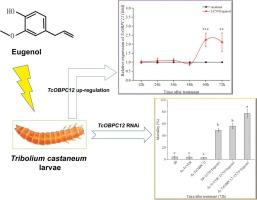Pesticide Biochemistry and Physiology ( IF 4.2 ) Pub Date : 2021-09-22 , DOI: 10.1016/j.pestbp.2021.104968 Shanshan Gao 1 , Ruixue Lu 1 , Yonglei Zhang 2 , Haidi Sun 1 , Siying Li 1 , Kunpeng Zhang 1 , Ruimin Li 1

|
Tribolium castaneum (T. castaneum) is a worldwide pest of stored grain that mainly harms flour, and not only causes serious loss of flour quality but also leads to deterioration of flour quality. Chemical detection plays a key role in insect behavior, and the role of odorant-binding proteins (OBPs) in insect chemical detection has been widely studied. However, the mechanism of OBPs in insect defense against exogenous toxic substances is still unclear. In this study, biochemical analysis showed that eugenol, the active component of A. vulgaris essential oil, significantly induced the expression of the OBP gene OBPC12 from T. castaneum (TcOBPC12). The mortality of late larvae treated with eugenol was higher than that of the control group after RNA interference (RNAi) against TcOBPC12, which indicates that the OBP gene is involved in the eugenol defense mechanism and leads to a decrease in sensitivity to eugenol. Tissue expression profiling showed that the expression of TcOBPC12 in the epidermis, hemolymph, and intestine was higher than in other larval tissues, and TcOBPC12 was expressed mainly in the epidermis, head, and fat body of adults. The developmental expression profile showed that the expression of TcOBPC12 in late eggs, early and late larval stages, and late adult stages was higher than in other developmental stages. These data suggest that TcOBPC12 may be involved in the absorption of exogenous toxic substances by the larvae from T. castaneum. Our results provide a theoretical basis for the metabolism and degradation mechanism of exogenous toxic substances and help explore more potential target genes of insect pests.
中文翻译:

气味结合蛋白 C12 参与对抗 Tribolium castaneum 中丁香酚的防御
Tribolium castaneum ( T. castaneum ) 是一种世界性的贮粮害虫,主要危害面粉,不仅严重影响面粉品质,还会导致面粉品质变差。化学检测在昆虫行为中起着关键作用,气味结合蛋白 (OBP) 在昆虫化学检测中的作用已被广泛研究。然而,OBPs 在昆虫防御外源有毒物质方面的机制尚不清楚。在这项研究中,生物化学分析表明,丁香酚,的活性成分A.寻常精油,显著诱导OBP基因的表达OBPC12从赤拟谷盗(TcOBPC12)。丁香酚处理后期幼虫的死亡率高于对照组,在RNA干扰(RNAi)TcOBPC12后,这表明OBP基因参与丁香酚防御机制并导致对丁香酚敏感性降低。组织表达谱显示,TcOBPC12在表皮、血淋巴和肠道中的表达高于其他幼虫组织,TcOBPC12主要在成虫的表皮、头部和脂肪体中表达。发育表达谱表明,TcOBPC12在卵晚期、幼虫早期和晚期、成虫晚期的表达高于其他发育阶段。这些数据表明TcOBPC12T. castaneum幼虫可能参与吸收外源性有毒物质。我们的研究结果为外源有毒物质的代谢和降解机制提供了理论依据,有助于探索更多潜在的害虫靶基因。











































 京公网安备 11010802027423号
京公网安备 11010802027423号